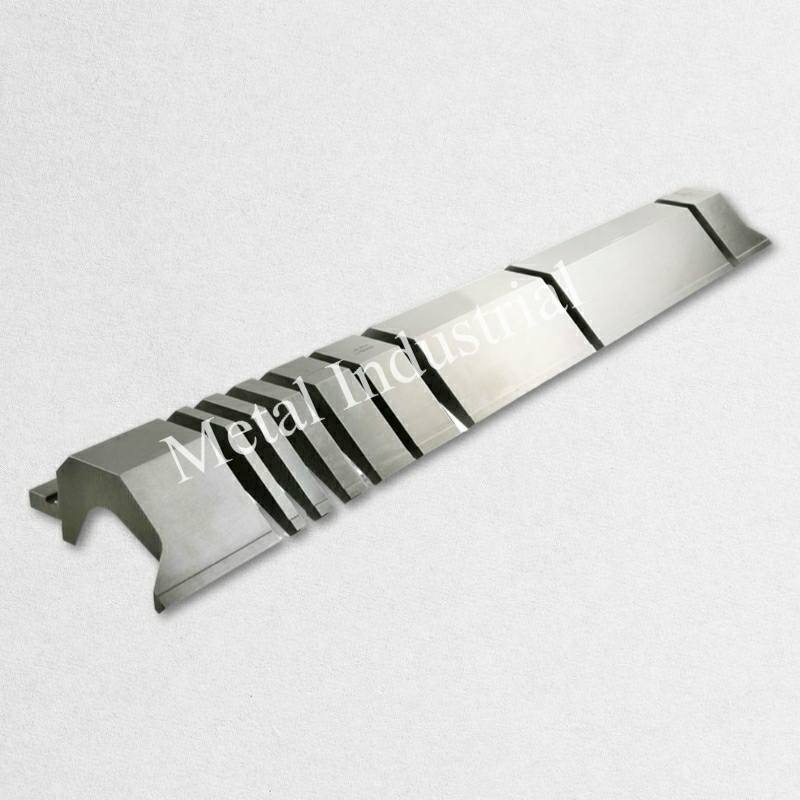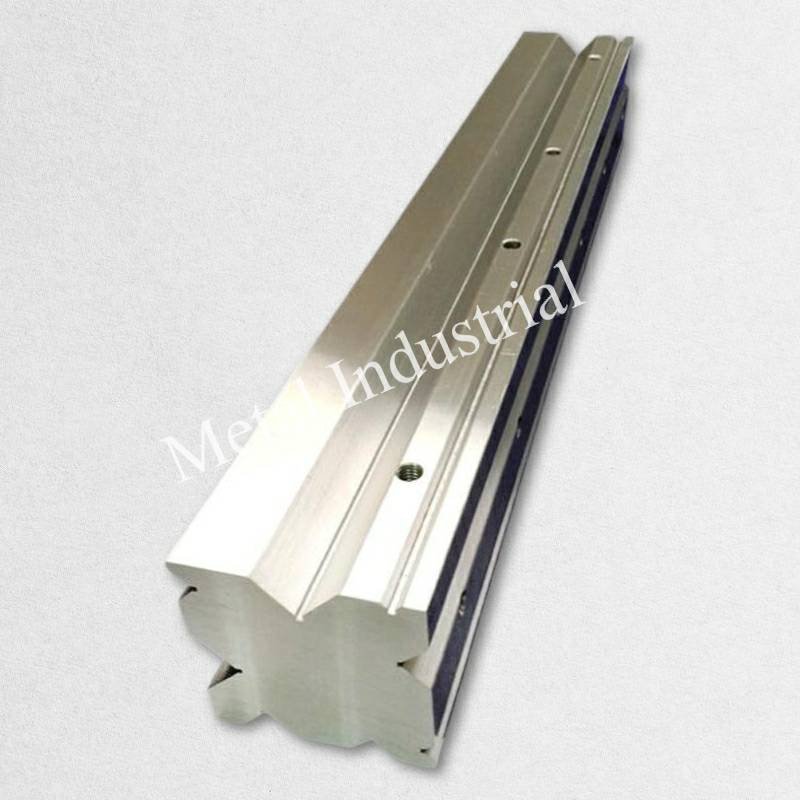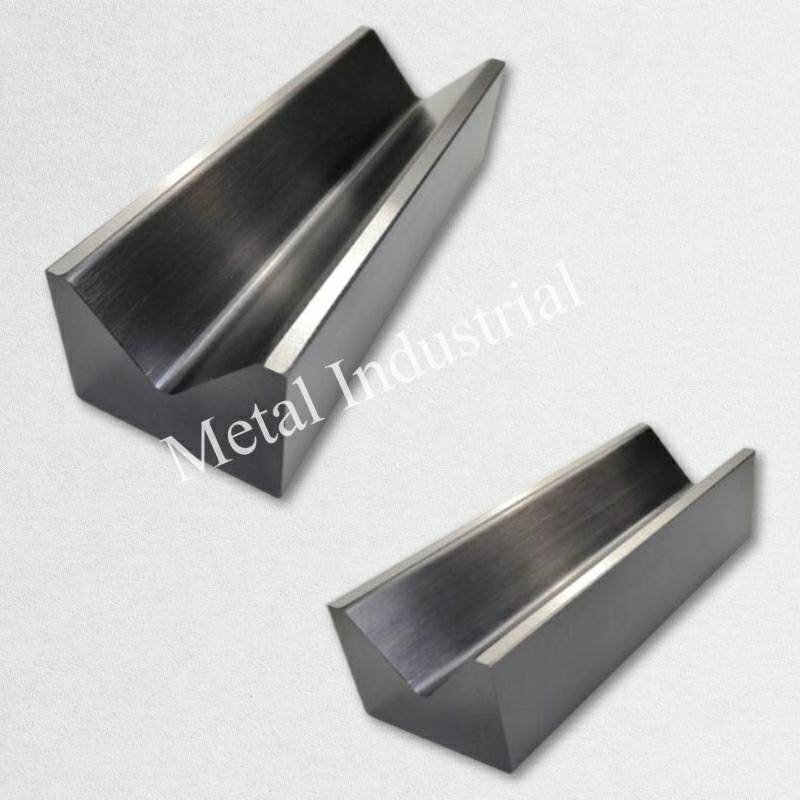금속 시트 벤딩 머신은 제조에 널리 사용되는 중요한 금속 가공 장비입니다. 효율적이고 정밀한 굽힘 기능으로 인해 생산 라인에서 없어서는 안 될 구성 요소입니다. 이번 블로그 게시물에서는 유지 관리에 대한 통찰력과 함께 벤딩 머신의 구성, 작동 원리, 중요한 소모품 부품을 자세히 살펴보겠습니다. 재료 선택 및 굽힘 금형의 맞춤화에 관한 권장 사항도 제공됩니다.

1. 벤딩 머신의 작동 원리 및 구성 요소:
1.1 작동 원리
굽힘 기계는 유압 또는 기계 시스템을 기반으로 작동합니다. 유압 시스템은 전력을 공급하여 램의 위아래 운동을 구동하여 금속판을 굽힙니다. CNC 시스템은 굽힘 각도와 모양을 정밀하게 제어하여 생산된 품목이 설계 요구 사항을 충족하도록 합니다.
1.2 주요 구성 요소
벤딩 머신의 주요 구성 요소로는 프레임, 베드, 램, 베드 축, 빔, 상부 및 하부 다이, 유압 시스템, 전기 시스템 및 CNC 시스템이 있습니다. 각 부품은 금속판 굽힘 작업을 수행하기 위해 협력하여 특정 역할을 수행합니다.
1.2.1 액자: 견고한 강철로 제작된 프레임은 벤딩 머신 전체를 지지하는 구조로 안정성과 강성을 보장합니다.
1.2.2 침대: 베드는 금속 시트를 배치하고 가공을 위해 이를 지지하고 고정하는 플랫폼입니다. 베드의 T-슬롯은 금형의 클램핑 및 고정을 용이하게 합니다.
1.2.3 램: 프레임에 연결되는 램은 상부 다이를 장착한 이동식 부품입니다. 이는 위아래로 움직이며 유압 실린더나 기계식 구동 시스템을 통해 금속 시트를 구부립니다.
1.2.4 침대 축: 침대 축은 작업대의 상하 이동을 제어하며 일반적으로 유압 실린더 또는 나사 메커니즘에 의해 구동됩니다.
1.2.5 빔: 빔은 프레임과 램을 연결하여 지지와 안내를 제공합니다. 일반적으로 원활한 램 이동을 보장하는 견고한 구조입니다.
1.2.6 상부 및 하부 다이: 상부 및 하부 다이는 금속판을 구부리는 데 사용되는 도구입니다. 상단 다이는 램에 장착되고 하단 다이는 베드에 고정됩니다. 모양과 크기에 따라 금속판의 최종 굽힘 모양이 결정됩니다.
1.2.7 유압 시스템: 대부분의 현대식 강판 굽힘 기계는 유압 시스템을 사용하여 동력을 제공하고 유압 실린더를 사용하여 램의 상하 동작을 구동합니다. 유압 시스템에는 오일 펌프, 탱크, 유압 실린더, 밸브 등과 같은 구성 요소가 포함됩니다.
1.2.8 전기 시스템: 전기 시스템은 램과 작업대의 상하 동작을 포함하여 다양한 기계 움직임을 제어합니다. 일반적으로 전기 제어 캐비닛, 제어판, 센서 등으로 구성됩니다.
1.2.9 CNC 시스템: 고급 벤딩 머신에는 CNC 시스템이 장착되어 있는 경우가 많으며 사전 프로그래밍을 통해 자동화된 작업이 가능하여 생산 효율성과 정확성이 향상됩니다.

2. 소모성 부품의 유지 관리:
벤딩머신의 주요 구성품 중 일부 부품은 마모 및 손상되기 쉬우므로 정기적인 점검 및 유지보수가 필요합니다. 일반적인 소모품은 다음과 같습니다.
- 다이(상부 및 하부): 금속 시트와 직접 접촉하는 다이는 마모되기 쉽습니다. 빈번한 굽힘 작업은 표면 마모로 이어져 굽힘 품질에 영향을 줄 수 있습니다. 정기적인 검사와 심하게 마모된 다이의 교체가 필요합니다.
- 유압 실린더: 램의 상하 운동을 구동하는 유압 실린더는 강한 압력과 빈번한 움직임 하에서 중요한 구성 요소입니다. 씰과 피스톤 로드는 마모되기 쉽고 유압 시스템 누출을 일으킵니다. 유압 실린더의 손상된 부품을 정기적으로 검사하고 교체하는 것은 유지 관리의 일부입니다.
- 빔: 프레임과 램을 연결하는 빔은 상당한 응력을 받습니다. 독특한 구조로 인해 장기간 사용시 피로균열이 발생할 수 있습니다. 정기적인 구조 점검과 필요한 수리가 중요합니다.
- 가이드 및 베어링: 기계의 슬라이더와 빔은 종종 가이드와 롤링 베어링을 사용하여 안내합니다. 이러한 부품은 먼지와 금속 파편과 같은 외부 요인에 취약하여 마찰과 마모가 증가합니다. 정기적인 청소와 윤활이 필요합니다.
- 전기 부품: 전기 시스템의 스위치, 센서, 케이블 및 기타 전기 부품은 환경 요인의 영향을 받아 오작동을 일으킬 수 있습니다. 정기적인 점검, 전기 부품의 청소, 손상된 부품의 교체는 필수적입니다.
- 유압 오일: 유압 시스템에 사용되는 유압 오일은 시간이 지남에 따라 오염되고 노화되어 시스템 성능에 영향을 미칠 수 있습니다. 유압 오일을 정기적으로 교체하고 유압 시스템의 청결을 보장하는 것은 유지 관리의 일부입니다.
벤딩 머신의 정상적인 작동을 보장하고 생산 효율성을 향상시키며 장비 수명을 연장하려면 이러한 부품을 정기적으로 유지 관리하고 적시에 교체하는 것이 중요합니다.

3. 벤딩 머신 몰드:
3.1 금형 재료 선택:
공통재료 벤딩 머신 금형 고속공구강, 합금공구강, 초경 등이 있습니다. 다양한 재료는 다양한 유형의 금속 시트를 가공하는 데 적합한 다양한 특성을 가지고 있습니다. 다음은 몇 가지 일반적인 벤딩 머신 금형 재료 및 응용 분야입니다.
- 고속 공구강: 내마모성과 강성이 우수합니다. 일반 냉간압연, 열연강판 및 덜 단단한 스테인레스강 가공에 적합합니다. 중간에서 낮은 재료 강도를 갖는 굽힘 작업에 대한 비용 효율적인 선택입니다.
- 합금 공구강: 여러 합금 원소가 포함되어 있어 더 높은 경도와 내마모성을 제공합니다. 고강도강, 스테인리스강 등 고강도 금속판 가공에 적합한 금형입니다.
- 카바이드: 초경은 경도와 내마모성이 매우 높아 고경도, 고강도 금속판 가공에 적합합니다. 초경 금형은 초경강 및 내마모강과 같이 내마모성이 높은 재료를 다루는 데 탁월합니다.
- 경화 및 강화 강철: 이 금형은 담금질 및 템퍼링 처리를 거쳐 일정 수준의 경도와 강도를 제공합니다. 이는 일반적인 금속판 굽힘에 적합하며 상대적으로 저렴한 비용을 제공합니다.
적절한 벤딩 머신 금형 재료를 선택하는 것은 작업 재료의 특성, 경도, 두께 및 특정 가공 요구 사항에 따라 달라집니다. 일반적으로 실제 응용 분야에서는 다양한 굽힘 작업과 금속 시트 특성을 기반으로 유연한 선택이 필요합니다.
3.2 금형 유형:
3.2.1 상부 다이:
- 위치 및 설치: 굽힘 기계의 램에 장착됨 상부 다이 기계 또는 유압 시스템을 통해 위아래로 움직이며 금속판에 직접 굽힘력을 가합니다.
- 모양과 디자인: 상부 다이의 모양과 디자인은 원하는 굽힘 모양에 따라 달라집니다. 일반적인 상부 다이 모양에는 V형, U형, 반원형 등이 있으며, 금속판의 굽힘 요구 사항에 따라 결정됩니다.
- 재료: 일반적으로 충분한 경도와 내마모성을 보장하기 위해 고속 공구강, 합금 공구강 또는 탄화물로 만들어집니다. 재료 선택에는 금속 시트의 경도, 두께 및 굽힘 작업 요구 사항이 고려됩니다.
- 굽힘 반경 및 각도: 상부 다이의 설계는 금속의 탄성 변형을 고려하여 굽힘 반경과 각도를 고려합니다. 특정 사전 굽힘 각도와 굽힘 보상을 설정하는 것이 필요할 수 있습니다.
- 교체성: 다양한 굽힘 작업을 수용하기 위해 일부 굽힘 기계에는 교체 가능한 상부 다이가 있습니다. 이를 통해 운영자는 필요에 따라 다양한 모양이나 크기를 선택할 수 있습니다.

3.2.2 하부 다이:
- 위치 및 설치: 그만큼 하부 다이 굽힘 기계의 작업대에 장착되며 일반적으로 고정됩니다. 상부 다이와 함께 작동하여 금속판 굽힘을 완료하기 위해 지지 및 위치 지정을 제공합니다.
- 모양과 디자인: 하부 다이의 모양은 굽힘 중 적절한 지지를 보장하기 위해 상부 다이와 조정됩니다. 하부 다이의 모양은 일반적으로 상부 다이의 설계 및 굽힘 작업에 따라 V형, U형 또는 기타 특정 모양입니다.
- 재료: 하부 다이의 재료는 일반적으로 상부 다이와 비슷하며, 내마모성과 경도를 보장하기 위해 적절한 공구강이나 카바이드 중에서 선택됩니다.
- 굽힘 반경 및 각도: 하부 다이의 설계는 굽힘 반경과 각도도 고려하여 굽힘 중에 금속판을 안정적으로 지지하도록 보장합니다.
- 청소 및 유지관리: 하부 다이는 일반적으로 작업대에 고정되어 있으므로 금속 파편과 먼지에 더 취약할 수 있습니다. 따라서 올바른 작동을 보장하려면 하부 다이를 정기적으로 청소하고 유지 관리하는 것이 중요합니다.
상부 및 하부 다이의 설계 및 선택은 특정 굽힘 작업 요구 사항, 금속 시트의 특성 및 굽힘 기계 사양에 따라 달라집니다. 적절한 금형 선택과 유지 관리는 굽힘 품질과 생산 효율성을 향상시킬 수 있습니다.

3.3 맞춤형 벤딩 금형의 필요성:
금속 시트 굽힘 기계 작동 시 기본 굽힘 작업에는 표준 금형이면 충분할 수 있습니다. 그러나 특별한 모양이나 복잡한 요구 사항이 있는 경우에는 맞춤형 벤딩 금형이 중요합니다.
맞춤형 금형의 장점:
- 모양 일치: 맞춤형 금형은 불규칙한 부품의 특정 모양과 일치하도록 정밀하게 설계되었습니다. 이는 굽힘 과정 중에 적절한 지지와 변형을 보장하여 불필요한 변형이나 손상을 방지합니다.
- 향상된 생산 효율성: 맞춤형 금형을 사용하면 불규칙한 부품의 굽힘 작업을 더 빠르게 완료하여 생산 주기를 단축할 수 있습니다. 다양한 모양을 수용하기 위해 끊임없이 변화하는 표준 금형에 비해 맞춤형 금형을 사용하면 더 빠르고 효율적인 생산 공정이 가능합니다.
- 품질 보증: 맞춤형 금형의 정밀한 설계와 적응성은 굽힘 일관성과 품질을 보장하고 불량 제품 비율을 줄입니다. 이는 고정밀 부품 생산에 특히 중요합니다.
- 높은 적응성: 생산 요구 사항이 변화함에 따라 맞춤형 금형을 새로운 설계 요구 사항에 따라 조정하여 적응성을 높이고 금형 변경 빈도를 줄일 수 있습니다.
결론:
위에서 설명한 시나리오를 통해 특별한 모양이나 복잡한 요구 사항이 있는 생산 환경에서 맞춤형 벤딩 금형이 생산 효율성을 향상시킬 뿐만 아니라 제품 품질도 보장한다는 것이 분명해졌습니다. 따라서 벤딩 머신 금형을 선택할 때 실제 생산 요구 사항에 따라 금형을 맞춤화하는 것이 현명한 선택이며 생산 라인에 더 큰 유연성과 경쟁 우위를 가져다줍니다.

3.4 벤딩 금형의 맞춤화:
굽힘 기계의 상부 및 하부 금형을 맞춤화할 때 금형이 굽힘 작업의 특정 요구 사항을 충족하는지 확인하려면 자세한 정보 세트를 제공하는 것이 중요합니다. 절곡기 금형을 맞춤화할 때 제공해야 할 주요 정보는 다음과 같습니다.
- 굽힘 작업의 요구 사항 및 사양: 여기에는 특정 굽힘 각도, 모양, 길이 및 기타 세부 요구 사항이 포함됩니다. 굽힘 작업에 대한 명확한 지침은 금형 설계가 예상 굽힘 표준에 부합하는지 확인하는 데 도움이 됩니다.
- Metal 시트의 특성: 금속판의 경도, 두께, 재질, 기타 특성에 대한 정보 제공이 필수적입니다. 금속 시트 특성이 다르면 굽힘의 정확성과 품질을 보장하기 위해 다양한 유형의 금형이 필요합니다.
- 금형 모양 및 크기에 대한 설계 요구 사항: 상부 및 하부 금형 모두에 대한 모양, 크기, 굽힘 반경 및 기타 관련 세부 사항과 같은 매개변수를 명확하게 지정합니다. 이러한 설계 요구 사항은 최종 굽힘 결과에 직접적인 영향을 미칩니다.
- 벤딩 머신의 사양 및 모델: 벤딩 머신의 정확한 사양과 모델 정보를 보장하는 것은 금형 설계를 기계에 맞추는 데 중요합니다.
- 굽힘 반경 및 각도에 대한 정확한 요구 사항: 굽힘 작업에 특정 굽힘 반경 및 각도 요구 사항이 있는 경우 금형 설계가 요구 사항을 충족하는지 확인하기 위해 정확한 수치를 제공해야 합니다.
- 예상 생산 배치 및 사용 빈도: 예상되는 생산 배치 및 금형 사용 빈도에 대한 정보를 제공하면 제조업체가 실제 생산 요구에 맞게 금형 설계 및 재료 선택을 최적화하는 데 도움이 됩니다.
- 특별 요구 사항 및 추가 기능: 특별한 요구 사항이 있거나 금형에 추가 기능(예: 빠른 변경 장치 또는 자동 조정 기능)이 필요한 경우 맞춤 제작 중에 이를 명확하게 명시해야 합니다.

위에서 설명한 대로 자세한 정보를 제공함으로써 벤딩 머신용 맞춤형 상부 및 하부 금형이 특정 요구 사항을 정확하게 충족하여 벤딩 품질과 생산 효율성을 향상시킬 수 있습니다.
금속 시트 벤딩 머신의 구성, 작동 원리 및 유지 관리에 대한 심층적인 지식을 얻으면 이 중요한 금속 가공 장비를 더 잘 이해하고 작동할 수 있는 장비를 갖추게 됩니다. 일상적인 사용에서 소모품, 특히 굽힘 금형에 대한 정기적인 유지 관리 및 관리는 장비가 원활하게 작동하고 수명을 연장하는 데 중요한 단계입니다.
4. 금속산업 소개
Nanjing Metal Industrial CO., Limited 나sa 제조업체 기계식 블레이드 중국에서 금속 가공, 가공, 식품 등을 포함한 산업을 위한 블레이드 및 액세서리를 생산합니다. 우리는 산업용 기계 블레이드, 기계 부품 및 재연삭 서비스의 제조 및 판매 분야에서 15년 이상의 경험을 보유하고 있습니다. 탁월한 생산 품질을 경험해 보시기 바랍니다.



10 응답
Tendrán el esquema eléctrico del tablero?
Los esquemas eléctricos son diferentes para cada fabricante, debe pedir los esquemas eléctricos al fabricante delequo de la máquina dobladora. Generalmente, el Diagrama eléctrico se encuentra en el manual de instrucciones de esa máquina dobladora.
여기 좋은 사이트가 있네요. 고품질을 찾는 게 어렵네요.
요즘 당신처럼 글을 쓰는 사람들이 정말 많아요. 정말 당신 같은 분들을 존경해요!
잘 지내세요!!
여기 좋은 사이트가 있네요.. 어렵네요
요즘은 yyours와 같은 고품질의 글을 찾을 수 없습니다.
정말 당신 같은 분들을 존경합니다! 몸조심하세요!!
유용한 정보네요. 우연히 이 사이트를 발견하게 되어서 정말 다행이에요.
그리고 왜 이 사고가 더 일찍 일어나지 않았는지 놀랍습니다!
북마크했어요.
감사합니다! 저희는 산업용 블레이드에 대한 전문 지식을 매주 정기적으로 업데이트할 예정이니, 블로그 구독을 부탁드립니다.
안녕하세요, 이 블로그 정말 좋은 것 같아요. 우연히 발견하게 되었는데,
) 북마크해두었으니 다시 방문하겠습니다.
돈과 자유는 변화의 가장 좋은 방법입니다.
부자가 되어 계속해서 다른 사람들을 도우세요.
감사합니다! 맞춤형 산업용 칼날이 필요하시면 언제든지 연락주세요.
당신이 어디서 정보를 얻고 있는지는 잘 모르겠지만, 좋은 주제입니다.
나는 더 많이 배우거나 이해하기 위해 시간을 투자해야 합니다.
더 많은 정보. 좋은 정보를 주셔서 감사합니다. 저는 이 정보를 찾고 있었습니다.
내 임무.